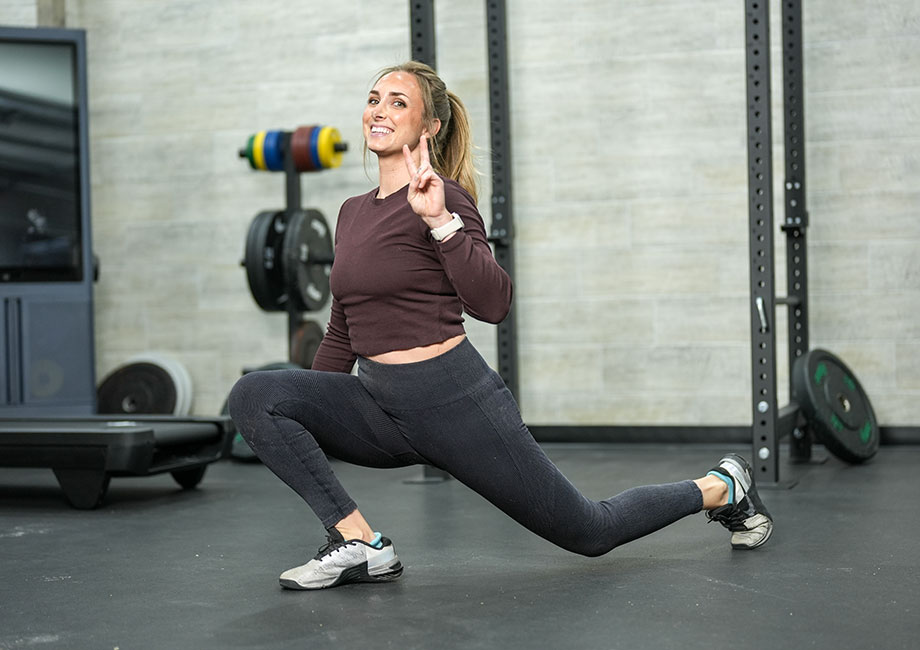We test and review fitness products based on an independent, multi-point methodology. If you use our links to purchase something, we may earn a commission. Read our disclosures.
Beginners are often given the same directions when first learning to squat, including the cue to cap your range of motion once your thighs are parallel to the floor. Most studies, like this 2001 review in Medicine and Science in Sports and Exercise1, advise doing parallel squats over deep squats “because injury potential to the menisci and cruciate and collateral ligaments” may be as your knees track past your toes.
Ben Patrick, founder of Athletic Truth Group, believes otherwise. Patrick claims that deeper squats, or “ass-to-grass” split squats, work to prevent and reduce knee pain by strengthening the knee joint in a way that parallel squats cannot. This may seem contradictory to what the fitness community considers common knowledge, but Patrick’s clients and fan base, more than two million strong on Instagram, swear by his methods and claim to have gotten great results.
Kate Meier, NASM-CPT, USAW-L1, CF-L1, and GGR head of content, provides an in-depth look at the ATG split squat, including how to do them, why you should do them, and more.
Open those hips, stretch those hammies, and let’s get to work!
How to Do the ATG Split Squat
Muscles worked: Quadriceps, glutes, hamstrings, hip adductors, core
How to do it:
- If using weight, load a barbell, unrack it onto your shoulders, and step away from the rack.
- Step your front foot approximately two feet forward.
- Drive your hips down and forward, leaning into the front leg as you move.
- Continue until your front knee reaches full flexion.
- Drive through the front heel to return to the starting position.
- Complete the desired number of reps, then switch sides and repeat.
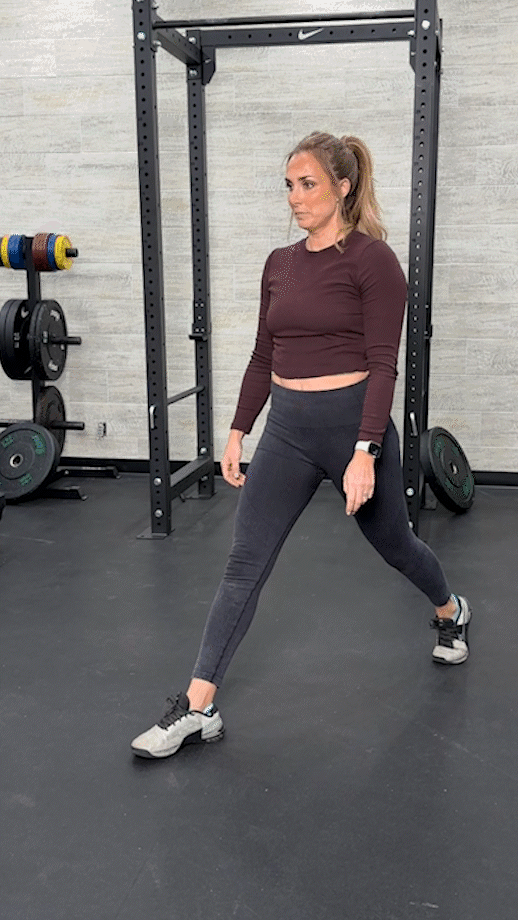
Trainer Tips for Form
The ATG split squat provides unparalleled benefits when performed correctly. Here are our top trainer tips for doing ATG split squats with proper form.
Knees Over Toes
Ben Patrick wouldn’t be the “Knees Over Toes Guy” if it wasn’t a focal point of his program.
According to Patrick, everyday movements like descending stairs, kneeling, and crouching all involve your knees passing in front of your toes. Sport-specific movements—such as leaping to dunk a basketball or sprinting—involve this positioning as well.
RELATED: What Is Functional Fitness?
ATG split squats too require you to throw out what you know about proper knee biomechanics and push past the point where your thighs are parallel with the floor.
“The point of the ATG split squat is to go as low as possible,” says Kate Meier, NASM-CPT, USAW-L1, CF-L1. “In the end position, your front knee should be fully bent with the back of your thigh coming into contact with your calf. Push as far as possible without letting your front heel come off the floor.”
Fancy Footwork
The front leg bears most, if not all, of your weight, so it’s critical to keep your front foot planted from start to finish. Your back foot, on the other hand, should have the heel to come off the floor with some weight on your toes. You’ll also want your back knee to touch the floor as you approach your end position.
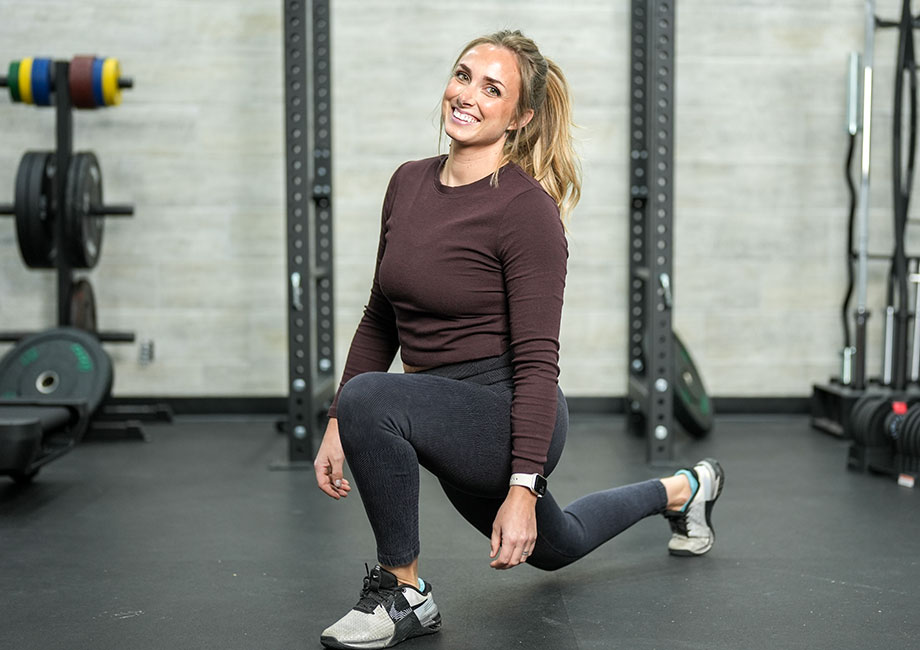
“Make sure to leave plenty of space between your front and back legs,” says Kate. “The ATG split squat is much deeper than the regular version, so you’ll need ample room to stretch out.”
Maintain a Neutral Spine
The ATG split squat is a lower-body workout, so of course, we’re going to discuss how you should position your legs, but what about the upper body?
“As with virtually all squats and squat variations, maintaining a neutral neck and spine is crucial for keeping your risk of injury low,” says Kate. “Keep your back straight, core braced, and eyes forward at all times.”
Flex Those Hips
Squats require a good degree of hip and ankle mobility. Split squats require a little more than your run-of-the-mill back squat. ATG split squats take things a step further, requiring even more mobility and flexibility to perform with good form.
Tight hip flexors will seriously impede your ability to get depth during the ATG split squat, so give yourself your best chance at success by working hip flexor exercises into your warm-up.
ATG Split Squat Benefits
Why are ATG split squats worthy of your time and attention? We’re glad you asked.
Improved Hip, Knee, and Ankle Mobility
Performing ATG split squats, especially if you’re using a light barbell for resistance, is basically a loaded stretch. The exercise requires your hips, knees, and ankles to move through a massive range of motion, improving mobility, flexibility, and stability in these crucial joints.
RELATED: Best Olympic Barbell
It’s also low-impact, which your joints will love.
Builds Lower Body Muscles
That epic range of motion will also help you build your quads, glutes, and hammies, as these important lower-body muscles will activate to accommodate the movement.
Adding a light barbell, pair of dumbbells, or even a kettlebell, held as you would during a goblet squat, will provide even more activation, helping you make great strides towards your fitness goals.
RELATED: Best Dumbbells
Reduced Lower Back and Knee Pain
According to the Clinical Journal of Sport Medicine2, hip and leg strengthening exercises can have a positive effect on individuals suffering from chronic knee pain and conditions like osteoarthritis, reducing symptoms and improving their overall quality of life.
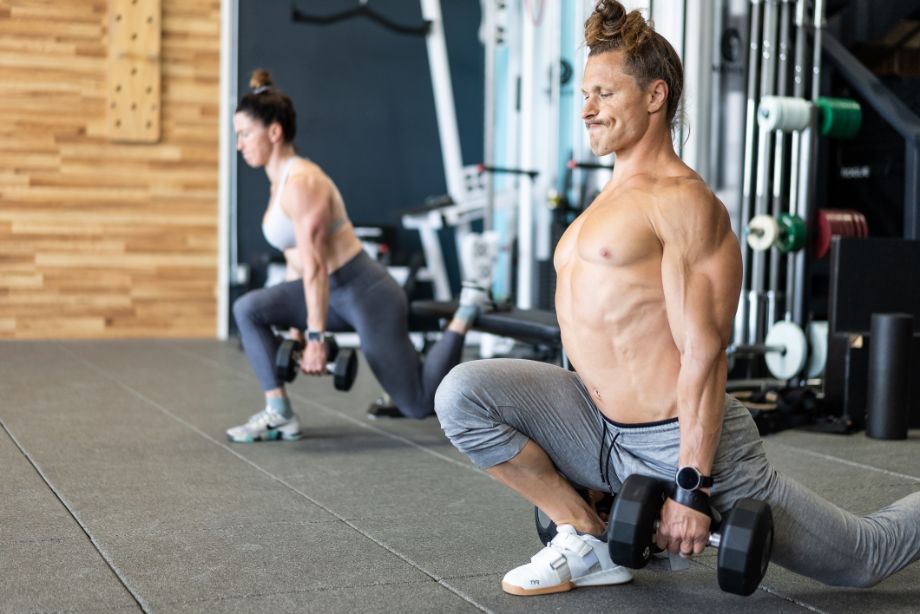
ATG split squats lengthen and strengthen the hips and leg muscles, providing some knee relief. The movement also stretches the hip flexors, contributing to the reduction and prevention of lower back pain.
Ben Patrick cites the above as why his subscribers live a generally more pain-free life than those still doing traditional squats and squat variations. We can’t truly confirm his claims, but the sheer magnitude of Patrick’s following does lend some credence to his program.
If you have a physical or medical condition that causes you lower back or knee pain, consult your doctor before trying a new fitness regimen, including ATG training.
Common ATG Split Squat Mistakes
You’ve been practicing and improving your ATG split squat by leaps and bounds, but are you sure you’re getting the form perfect on each rep? Here are some common mistakes to avoid.
Not Enough Depth
We’re not talking about the depth you get from reciting poetry and pondering the meaning of life; we, of course, mean physical depth. After all, that’s the whole point of the ATG split squat— to get that ass to the grass!
“The ATG is meant to be deep, meaning your hamstring and calf should touch on every rep,” says Kate Meier, NASM-CPT, USAW-L1, CF-L1. “That may be hard if you’re lacking the hip or ankle mobility to get there. Using a wedge or weight plate to elevate your front heel helps increase ankle mobility. A great pair of weightlifting shoes should help, too.”
RELATED: Best Slant Boards
Not Enough Weight on Front Leg
Don’t get it twisted; the back leg is active during the ATG split squat. The majority of your body weight should be shifted to your front leg—specifically your front heel—so you can stabilize your body and get a good drive coming out of the movement.
But, you’ll still want to engage your back leg without leaving too much weight in the back, resulting in an unstable posture. You’ll likely wobble, and you may fall, turning your “ass-to-grass” into a “face-to-grass” instead. Ouch!
How to Program the ATG Split Squat
The ATG split squat makes a great addition to calisthenics training programs but can be converted into a strength training exercise using a barbell, kettlebell, or pair of dumbbells.
“ATG split squats make a good midway exercise during a leg day training split,” says Kate Meier, NASM-CPT, USAW-L1, CF-L1. “Generally speaking, I like to lead with a pure strength movement like the barbell back squat or front squat, then move onto accessory lifts and mobility exercises like the standard, Bulgarian, or ATG split squat.”
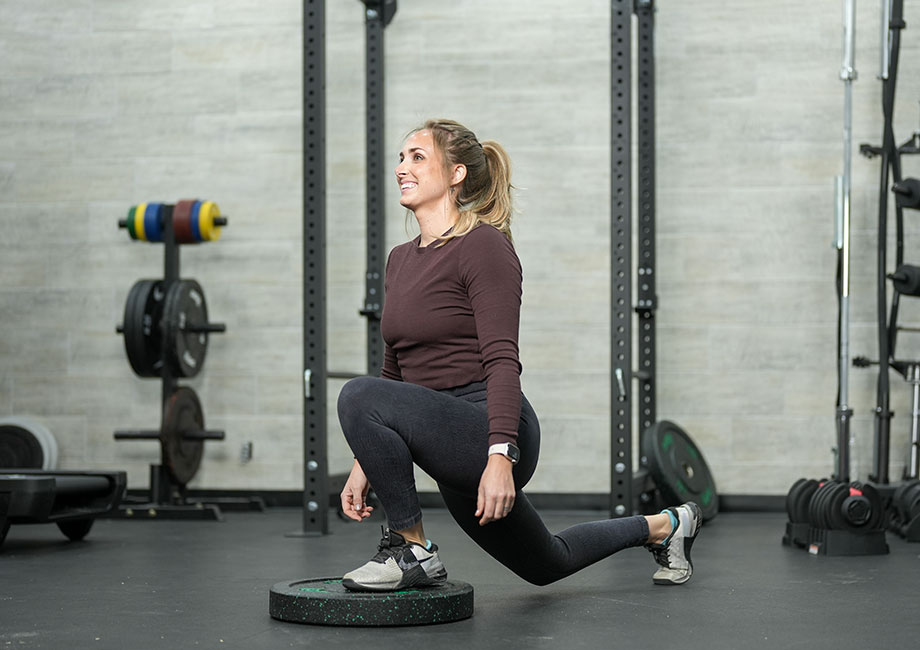
How many reps you pencil in depends on your personal goals:
- For strength: Perform 2-6 sets of 1-5 reps using heavy weight
- For hypertrophy: Perform 3-6 sets of 6-12 reps using moderate weight
- For endurance: Perform 2-3 sets of 12-20 reps using light weight or no weight
Don’t forget—the ATG split squat puts beginners and intermediate fitness enthusiasts in a position they likely are not accustomed to. Even after ample practice, it’s ill-advised to go too heavy on an ATG split squat, as too much weight can put stress on the hips or hamstrings and contribute to an injury.
Start light, take it slow, and work with a personal trainer if you need the watchful eye and guidance of a fitness professional.
RELATED: How Many Reps To Build Muscle
Who Should Do the ATG Split Squat?
We’re fitness-inclusive folks at GGR, so we’re keen to recommend every exercise to everyone. The ATG split squat may be a rare exception because, let’s not mince words, it’s tough!
Those looking to improve their flexibility may consider adding the ATG split squat to their leg day workouts. As Ben Patrick puts it, the ATG encourages “true hip extension,” opening up the hips in a way exercises cannot.
Professional athletes, Olympic hopefuls, powerlifting contestants, and bodybuilders may consider incorporating the ATG split squat as well because of its unique movement pattern, which lengthens the lower body muscles, opens the hips, and provides a different stimulus to the lower-body muscle groups to inspire strength gains and hypertrophy.
RELATED: Powerlifting Workout
ATG Split Squat Variations
Fitness aficionados may be ready to take their ATG split squats to the next step, while beginners may be looking for something a bit more manageable. We have recommendations for both.
Front-Foot Elevated ATG Split Squat
Why do it: Just as the Bulgarian split squat elevates the back leg to increase muscle activation, elevating the front foot during the ATG split squat increases the range of motion too, making this move a certified quad killer.
How to do it:
- Place a weight plate on the floor where your front foot will be, then get into your standard ATG split squat stance with your front foot planted on the plate.
- Drop your hips down and forward, leaning into your front leg as you descend.
- Continue until your front knee reaches full flexion.
- Drive through your front heel and return to the starting position.
- Complete the desired number of reps, then switch sides and repeat.
RELATED: Best Weight Plates
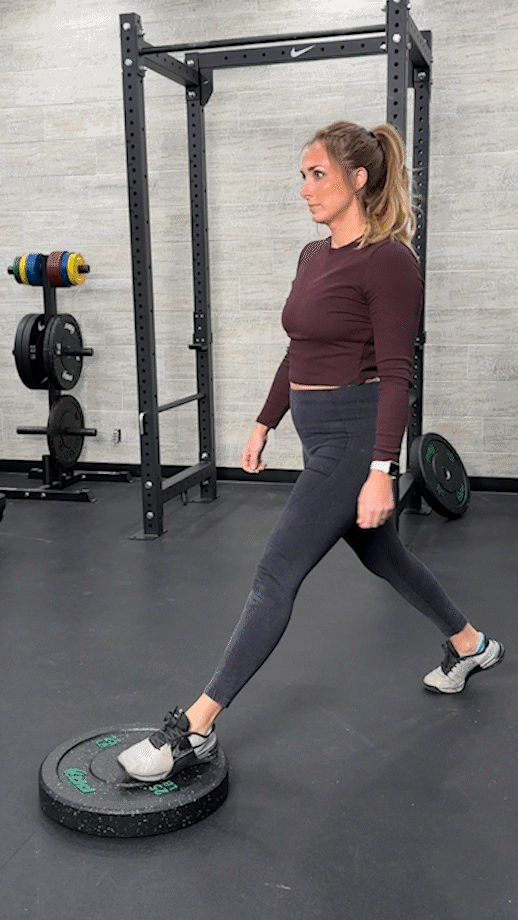
Standard Split Squat
Why do it: The ATG split squat requires a massive stretch that not everyone will be ready for. Starting with the standard split squat is, in that regard, the perfect stepping stone.
How to do it:
- Start from a standing position with your stance split (one foot in front of the other).
- Slowly lower your body towards the floor until your knees form 90-degree angles.
- Lightly touch the floor with your back knee, then drive through your front heel to stand.
- Complete the desired number of reps, then switch sides.
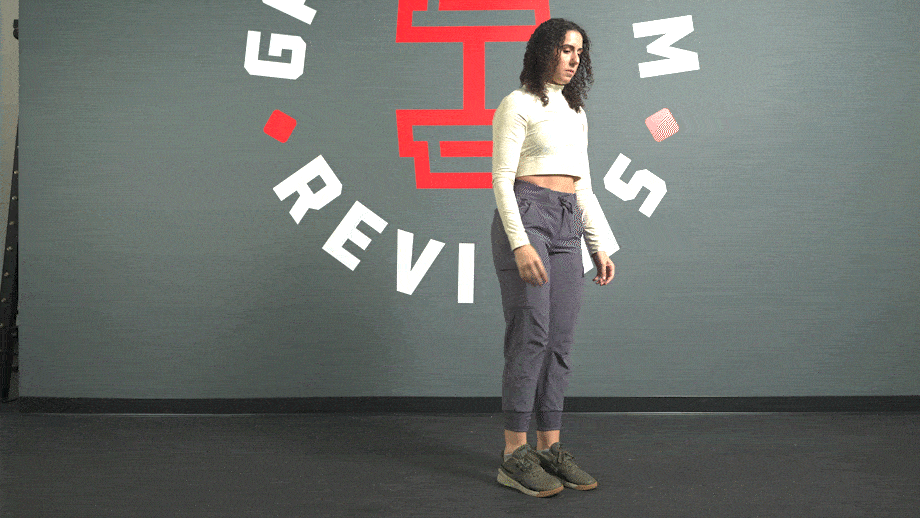
Dumbbell Step-Up
Why do it: “Step-ups are simple and effective,” says Kate Meier, NASM-CPT, USAW-L1, CF-L1. “With minimal equipment, you get maximal activation of the quads and glutes, which will help you perform ATG split squats as you progress and improve.”
How to do it:
- Stand in front of a step-up platform or weight bench, holding a dumbbell in each hand.
- Step up onto the platform or bench with your right foot, shifting your weight to your left leg.
- Plant your right foot and shift the weight into your right leg.
- Drive through your heel to push your body up, bringing your left leg to meet your right.
- Pause at the top, then step down.
- Repeat the movement with the same leg or alternating legs each rep.
RELATED: Step-Up Exercise
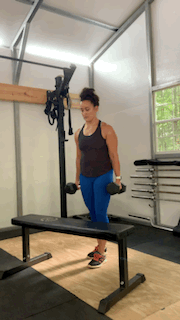
ATG Split Squat: FAQs
What is the ATG position?
ATG is an acronym that stands for “ass-to-grass.” The position involves squatting past the point where your thighs are parallel with the floor, bringing your knees to full flexion and bringing your behind towards the grass, floor, mat, or whatever type of surface you’re standing on.
What are the 10 ATG exercises?
Ben Patrick’s ATG system incorporates a variety of movements, including the sled push/pull, tibialis raise, Patrick step, knees over toes calf raise, monkey feet knee raise, ATG split squat, and more.
Check out Athletic Truth Group if you feel ATG training may be right for you.
Are split squats better than lunges?
“Split squats are better suited for strength training because most people are able to move more weight with a split squat than with the lunge,” says Kate Meier, NASM-CPT, USAW-L1, CF-L1, and GGR head of content. “That’s not to say the lunge is a waste; lunges are great for building cardio and muscular endurance.”
All things considered, they are both highly effective single-leg exercises worthy of a spot in your leg day rotation. For the best results, consider incorporating both into your workout routine.
RELATED: Unilateral Exercises
Do split squats hit glutes?
They sure do. Bust out a set of split squats right now, and you’re bound to feel the burn in your bum. The Journal of Strength and Conditioning Research3 observed EMG activity throughout the body during several lower-body exercises and confirmed activity in the gluteus maximus and gluteus medius during the split squat.
RELATED: Glute Exercises At Home
Start working both standard split and ATG split squats into your strength training, and you’ll soon have the buns of steel to show for it!
References
1. Escamilla RF. Knee biomechanics of the dynamic squat exercise. Med Sci Sports Exerc. 2001;33(1):127-141. doi:10.1097/00005768-200101000-00020
2. Lun V, Marsh A, Bray R, Lindsay D, Wiley P. Efficacy of Hip Strengthening Exercises Compared With Leg Strengthening Exercises on Knee Pain, Function, and Quality of Life in Patients With Knee Osteoarthritis. Clin J Sport Med. 2015;25(6):509-517. doi:10.1097/JSM.0000000000000170
3. Kipp K, Kim H, Wolf WI. Muscle Forces During the Squat, Split Squat, and Step-Up Across a Range of External Loads in College-Aged Men. J Strength Cond Res. 2022;36(2):314-323. doi:10.1519/JSC.0000000000003688
Further reading

In our Trifecta meal delivery review, we’ll go over our experience with this meal delivery service catered toward athletes and those with fitness goals. Read more

The best walking shoes for plantar fasciitis have ample cushioning and the proper support to absorb impact and keep your feet stable. These are our top picks. Read more

In this Nautilus E618 elliptical review, we’ll cover the specs and who will benefit from this at-home, low-impact cardio machine. Read more

Follow our easy guide on how to do a dumbbell bench press, plus reasons why you should incorporate this exercise into your routine. Read more

